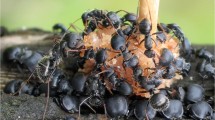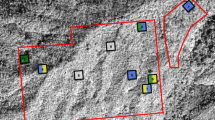Abstract
Coexisting populations of ecologically similar species may reduce competition by decreasing overlap in the resources they use, or by spatially or temporally partitioning shared resources. Temnothorax longispinosus and Temnothorax curvispinosus are morphologically similar acorn-nesting ant species that frequently co-occur in the leaf litter of deciduous forests of eastern North America. By conducting two detailed and complementary field surveys, we show that T. longispinosus and T. curvispinosus nest in a specialized subset of available acorns and that nests had a uniform pattern of spacing consistent with spatial displacement from competition. Colonies of both species were then subjected to laboratory preference tests, and interspecific and intraspecific competition experiments. The preference experiments demonstrated some level of differentiation in resource use among species within the specialized range of nest properties used by the ants in nature, potentially reducing competition during nest selection. Nevertheless, in both intraspecific competition experiments we found high mortality that increased when ants were initially in nests closer together. T. curvispinosus mortality also increased with the number of combatants, consistent with a battle of attrition between opposing sides. In contrast, T. longispinosus mortality decreased during battles as the number of combatants increased. In the interspecific battles, both T. curvispinosus and T. longispinosus sustained some mortality, but escalated battles did not occur. Broadly, this work demonstrates that direct competition over nesting sites is an important mechanism underlying the dispersion of Temnothorax nests and therefore the structuring of acorn-nesting Temnothorax assemblages.





Similar content being viewed by others
References
Adams ES, Tschinkel WR (1995) Density-dependent competition in fire ants: effects on colony survivorship and size variation. J Anim Ecol 64:315–324
Agrawal AA, Ackerly DD, Adler F, Arnold AE, Cáceres C, Doak DF, Post E, Hudson PJ, Maron J, Mooney KA (2007) Filling key gaps in population and community ecology. Front Ecol Environ 5:145–152
Alloway TM (1980) The origins of slavery in leptothoracine ants (Hymenoptera: Formicidae). Am Nat 115:247–261
Bengston S, Dornhaus A (2015) Latitudinal variation in behaviors linked to risk tolerance is driven by nest-site competition and spatial distribution in the ant Temnothorax rugatulus. Behav Ecol Sociobiol 69:1265–1274
Blüthgen N, Feldhaar H (2010) Food and shelter: how resources influence ant ecology. In: Lach L, Parr C, Abbott K (eds) Ant ecology. Oxford University Press, Oxford, pp 115–136
Booher D, Macgown JA, Hubbell SP, Duffield RM (2017) Density and dispersion of cavity dwelling ant species in nuts of eastern US forest floors. Trans Am Entomol Soc 143:79–93
Chase JM, Leibold MA (2003) Ecological niches: linking classical and contemporary approaches. University of Chicago Press, Chicago
Chesson P (2000) Mechanisms of maintenance of species diversity. Annu Rev Ecol Syst 31:343–366
Colwell RK, Fuentes ER (1975) Experimental studies of the niche. Annu Rev Ecol Syst 6:281–310
Debout G, Schatz B, Elias M, Mckey D (2007) Polydomy in ants: what we know, what we think we know, and what remains to be done. Biol J Linn Soc 90:319–348
Dornhaus A, Franks NR (2006) Colony size affects collective decision-making in the ant Temnothorax albipennis. Insect Soc 53:420–427
Franks NR, Dornhaus A, Fitzsimmons JP, Stevens M (2003) Speed versus accuracy in collective decision making. Proc R Soc B Biol Sci 270:2457–2463
Herbers JM (1986) Nest site limitation and facultative polygyny in the ant Leptothorax longispinosus. Behav Ecol Sociobiol 19:115–122
Herbers JM, Johnson CA (2007) Social structure and winter survival in acorn ants. Oikos 116:829–835
Hervé M (2014) RVAideMemoire: diverse basic statistical and graphical functions. URL: http://cran.r-project.org/package=RVAideMemoire
Irschick D, Dyer L, Sherry T (2005) Phylogenetic methodologies for studying specialization. Oikos 110:404–408
Jiménez-Soto E, Philpott SM (2015) Size matters: nest colonization patterns for twig-nesting ants. Ecol Evol 5:3288–3298
Levine JM, HilleRisLambers J (2009) The importance of niches for the maintenance of species diversity. Nature 461:254–257
MacArthur RH (1958) Population ecology of some warblers of northeastern coniferous forests. Ecology 39:599–619
Modlmeier AP, Foitzik S (2011) Productivity increases with variation in aggression among group members in Temnothorax ants. Behav Ecol 22:1026–1032
Möglich M (1978) Social organization of nest emigration in Leptothorax (Hym., Form.). Insect Soc 25:205–225
Morisita M (1959) Measuring the dispersion of individuals and analysis of the distributional patterns. Mem Fac Sci Kyushu Uni Series E 3:65–80
Parr CL, Gibb H (2010) Competition and the role of dominant ants. In: Lach L, Parr C, Abbott K (eds) Ant ecology. Oxford University Press, Oxford, pp 77–96
Pianka ER (1974) Niche overlap and diffuse competition. Proc Natl Acad Sci USA 71:2141–2145
Powell S (2009) How ecology shapes caste evolution: linking resource use, morphology, performance and fitness in a superorganism. J Evol Biol 22:1004–1013
Powell S, Costa AN, Lopes CT, Vasconcelos HL (2011) Canopy connectivity and the availability of diverse nesting resources affect species coexistence in arboreal ants. J Anim Ecol 80:352–360
Pratt SC (2005) Behavioral mechanisms of collective nest-site choice by the ant Temnothorax curvispinosus. Insect Soc 52:383–392
Pratt SC, Pierce NE (2001) The cavity-dwelling ant Leptothorax curvispinosus uses nest geometry to discriminate between potential homes. Anim Behav 62:281–287
R Development Core Team. 2016. R: a language and environment for statistical computing. R Foundation for Statistical Computing, Vienna
Sasaki T, Colling B, Sonnenschein A, Boggess MM, Pratt SC (2015) Flexibility of collective decision making during house hunting in Temnothorax ants. Behav Ecol Sociobiol 69:707–714
Schneider CA, Rasband WS, Eliceiri KW (2012) NIH Image to ImageJ: 25 years of image analysis. Nat Methods 9:671–675
Schoener TW (1974) Resource partitioning in ecological communities. Science 185:27–39
Shigesada N, Kawasaki K, Teramoto E (1979) Spatial segregation of interacting species. J Theor Biol 79:83–99
Tanner CJ (2006) Numerical assessment affects aggression and competitive ability: a team-fighting strategy for the ant Formica xerophila. Proc R Soc B Biol Sci 273:2737–2742
Tilman D (2004) Niche tradeoffs, neutrality, and community structure: a stochastic theory of resource competition, invasion, and community assembly. Proc Natl Acad Sci USA 101:10854–10861
Whittaker RH (1972) Evolution and measurement of species diversity. Taxon 21:213–251
Acknowledgements
RMP would like to thank Shauna Price and Paul Hoyt-O’Connor for their support, and was funded by a Harlan Research Fellowship from the George Washington University Department of Biological Sciences and the George Washington University Undergraduate Research Grant. KK was funded by a Harlan Research Fellowship from the George Washington University Department of Biological Sciences. SP was funded by National Science Foundation (NSF) grant DEB 0842144 and the George Washington University, with additional support from NSF grant DEB 1442256.
Author information
Authors and Affiliations
Corresponding author
Rights and permissions
About this article
Cite this article
Prather, R.M., Kozmary, K. & Powell, S. Combat, co-existence, and resource partitioning in acorn-dwelling Temnothorax ants. Insect. Soc. 65, 455–463 (2018). https://doi.org/10.1007/s00040-018-0634-7
Received:
Revised:
Accepted:
Published:
Issue Date:
DOI: https://doi.org/10.1007/s00040-018-0634-7




